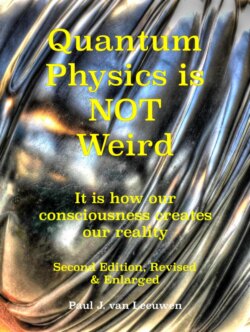Читать книгу Quantum Physics is NOT Weird - Paul J. van Leeuwen - Страница 5
На сайте Литреса книга снята с продажи.
Reading guide
ОглавлениеBrowsing the Internet, I find awkward titles like ‘Quantum mechanics for beginners’, ‘Quantum physics for beginners’ and even ‘Quantum physics for dummies’. Well, I assure you, quantum physics is not a subject for dummies. If you really want to understand the message of the quantum world then you will have to think and ponder long and deep. When you hear or read something like 'A quantum object is at the same time a particle and a wave’ and you don’t feel the slightest urge to tackle that paradox, I doubt you will ever master the real message of quantum physics. I recommend that, when you really want to make the contents of this book part of your intellectual property, read, re-read, and re-read again. Save the parts in every chapter, that do not really seem to land safely on first reading, just for later and read the chapter conclusion. You can always pick up later. Take your time.
Chapters 2 and 3 deal with the beginning and development of classical Newtonian physics until the moment that quantum physics made its ground-breaking entry at the start of the 20th century.
Chapters 4 and 5 are about how the quantum phenomena confronted the physicists with stunning problems and how they tried to deal with that.
Chapter 6 deals with eight of the most common quantum hypotheses and seven important experiments. Each experiment is carefully weighted concerning the significance of its results for the sustainability of those eight key hypotheses.
Chapter 7 deals in rigorous detail with the delayed choice experiments and explains and defends their logical implications for our concept of objective reality.
Chapters 8 to 10 discuss the possible connections between information, entropy and consciousness, the elusiveness of the photon and the character of time.
Chapter 11 is dedicated to that highly interesting new branch of biology, quantum biology, with emphasis on quantum tunneling in living systems.
Chapter 12 speculates about possible models of reality that could explain consciousness and its relationship with our experienced reality.
Chapter 13 deals with some proposals for experiments to falsify the models presented in chapter 12.
Chapter 14 deals with the concept of consilience and why that is an important way of mutual scientific confirmation for the existence of a consciousness being independent of the body.
Chapter 15 Contains a small but challenging collection of blogs from my website.
In the appendices you will find:
• Some isolated treatises on certain aspects in quantum physics which, while important, may have interrupted the continuity in the main text,
• How this book came about,
• A list of recommended literature and other media.
At the end you will find the notes and the glossary.
Notes: References to internet content are numbered [1], underlined, blue and in italic, like this: Internet [1]. The numbers correspond to the Notes section. Notes in each Chapter start with number 1. To spare you the copying of the URL’s there manually, go to the Notes page on my website.
Glossary: Newly introduced concepts will be explained in detail. When such a concept is highlighted and dark grey it is to be found in the glossary at the end of this book. You will find there a concise explanation as well as the page number where it was introduced for the first time. This can be of great help when you encounter the concept somewhere else and you would like to refresh your memory.
The most important thing through almost the entire book is to try to understand the workings and the implications of the double-slit experiment.
